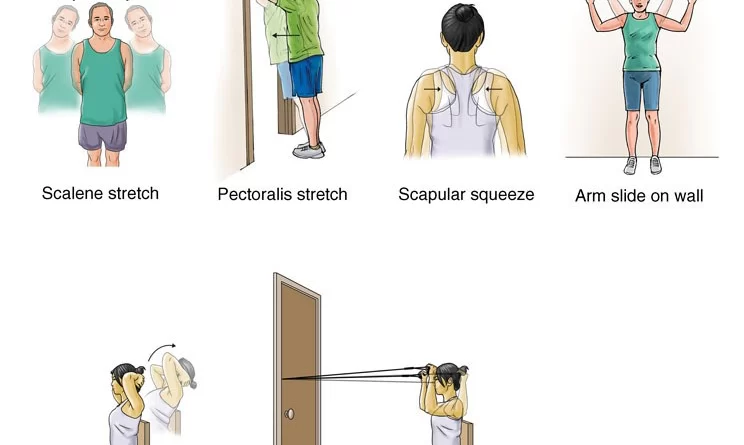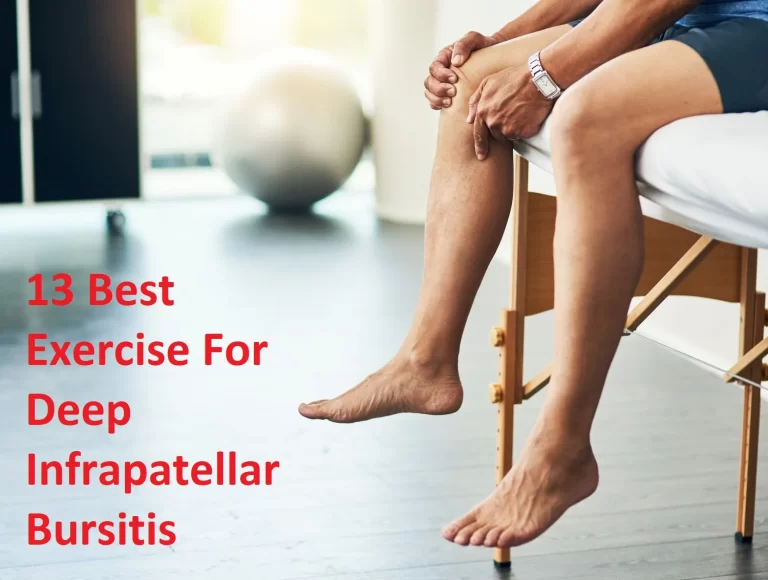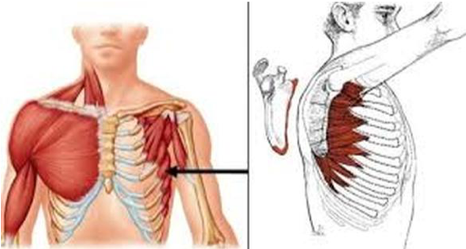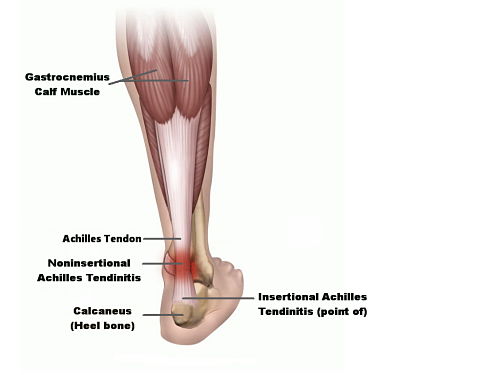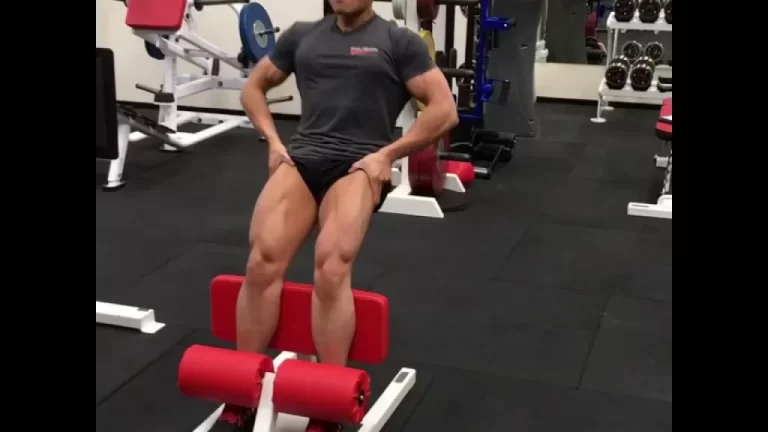Rectus abdominis muscle strengthening exercise
Table of Contents
What is the rectus abdominis strengthening exercise?
- Rectus abdominis strengthening exercise is a great way to make the abdominal wall more strong as well as powerful enough to do all lower back activities with ease & many health benefits associated with it.
The Rectus Abdominis made up of the top layer of the abdominal muscles, commonly referred to as the “six-pack.” This is two flat as well as parallel muscles separated by linea alba (a connective tissue). - The rectus abdominis muscle is situated between the ribs & the pubic bone at the front of a pelvis. When this muscle is contracted, the characteristic bumps or even bulges are commonly known as the six-pack. The main action of this muscle is to move the body between the rib cage as well as the pelvis. The main function of these muscles is Trunk flexion, which compresses abdominal viscera & expiration.
- To strengthen the rectus abdominis, the patient needs to do a variety of core exercises that include rectus abdominis exercises. The easiest way to accomplish this is to add the rectus abdominis workout to the routine. By strengthening a rectus abdominis muscle the patient will get a better posture & stronger abs. If the abdomen is strong it will help to alleviate the back pain & improve the ability to give better performance in sports as well as other activities.
Health benefits of the rectus abdominis strengthening exercise
- A good posture: When the rectus abdominis muscles are weak, the patient may naturally tend to slouch posture due you do not have the musculature to support proper alignment. Strong abdominals help the patient to maintain good posture by helping prop up the spine so it feels more natural to stand tall with the arms & legs in alignment.
- This exercise assists to maintain Balance & stability in motion.
- This exercise helps to reduce the risk of falls in seniors.
- Decrease risk for back pain.
- Helps to give a better performance in sports
- Helps to give the patient the Firm & toned trunk
- This exercise decreases Back Pain: The abdominal muscles act as the anchor for muscles of the middle as well as the lower back. If the abdominals are weak, this forces the back muscles to work harder to support the middle & lower back.
- Abdominal strength increases the endurance of the muscles of your back so you fatigue less easily and are less vulnerable to strain or injury.
- Strong abdominals assist to prevent an exaggerated anterior pelvic tilt. If the patient has an anterior pelvic tilt, he may feel too much pressure on the lower back’s discs & facet joints, flexible points that enable the back to flex.
- If the patient is already suffering from back pain then abdominal exercises may help you to alleviate the pain by creating strength in the muscles.
This exercise helps to increase the ability to bear weight.
Different types of strengthening exercises for the rectus abdominis muscle
Forearm Plank
- How to do this strengthening exercise: To perform this exercise the patient has to Lie down with forearms on the floor, elbows beneath shoulders, & legs extended behind you.
- Raise the toes so that only the forearms & toes touch the floor, the body will be in a straight line a few inches off the floor.
- Bring the tummy button towards the spine, by contracting the deep abdominal muscles & tightening the buttocks as well as the upper limb.
- Hold this position for 40 to 60 seconds before coming back to the starting position.

Reverse Crunch
- How to do this strengthening exercise: To perform this exercise the patient has to Lie down on the back with knees flexed & thighs perpendicular to the ground, hands at the sides, & feet on the floor.
- Contract the abdominal muscles & elevate the hips toward the rib cage. This will lift the coccyx off the ground & bring the knees toward the chest.
- Hold in this position for 2 seconds. Slowly lower back to the starting position.
- Do 10 to 20 repetitions in one session. Do two sessions per day.
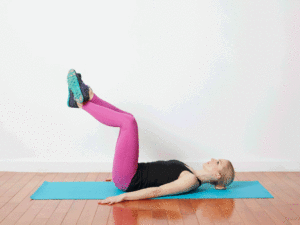
Scissor Flutter Kicks
- How to do this exercise: This exercise requires you to engage the core muscles, including the rectus abdominis, so that the patient can move the legs up & down.
- To do this exercise the patient has to take the supine lying position with the legs extended, & arms by the sides. Using an exercise mat will help reduce the pressure on the lower back.
- Press the lower back into the mat & tuck in the pelvis. It will help to engage the core.
- Lift both legs off the mat, about six inches to ten inches from the floor. The patient should not feel any pain in the back.
- Lower one leg toward the floor. As this leg gets close to the floor, raise the other leg.
- Continue scissoring the legs by slowly switching them up & down.
- Do 15 to 20 repetitions in a session. Do three sessions per day.

Toe Taps
- How to do this strengthening exercise: To perform this exercise a patient has to Lie down on the back with the knees flexed & feet lifted into the tabletop position.
- Press the lower back into the mat & contract the core.
- Slowly lower the left foot until the toe taps the floor. The foot should be in a flexed position. Engage the abdominal muscles & raise the left foot back up to the tabletop. Repeat on the right side.
- Do 8 to 10 repetitions on each side in one session. Do three sessions in a day.

Abdominal Crunches

- How to do this strengthening exercise:
- To perform this exercise the patient has to Lie down on the back with the knees flexed placing the hands behind the head or even across the chest. However, if the patient finds the neck is strained, he can keep one hand cradling the head. If the patient is putting the hands behind the head, the fingers should gently cradle the head. The idea is to support the neck without taking away from the work of the abdominals.
- Pull the tummy button towards the spine in preparation for the motion.
- Slowly engage the abdominals, bringing the shoulder blades about one or two inches off the floor.
- Breathe out as the patient come up & keep the neck straight, chin up. Imagine you are holding a tennis ball under your chin. That is about the angle you want to keep the chin the entire time.
- Hold at the top of the motion for a few seconds, breathing continuously.
- Slowly lower back down, but do not relax all the way.
- Repeat for 15 to 20 repetitions with perfect form for each rep.
Jack Knife Crunch
- How to do this strengthening exercise: To perform this exercise the patient has to Lie down on an exercise mat, extending the arms straight back behind the head.
- Flexed the spine and, at the same time, elevate the legs & arms to meet in the closed jackknife position.
- Breath out on the way up & breathe in on the way down
- Do not arch the back when lowering a leg.
- The neck should be in one line with the back.
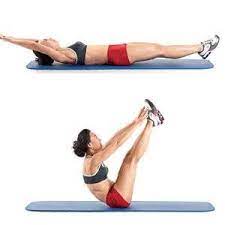
Reach and Tuck
- How to do this strengthening exercise: Embark on this exercise in a full pushup position. Hold a 5-pound weight in the right hand.
- Lift left leg off the floor while extending right arm forward to shoulder height & back leg parallel to the floor.
- Draw right elbow & left knee toward chest, tucking abs as well as raising hips slightly.
- Extend the arm & leg back to start as well as repeat.
- Do 2– sets of 20 repetitions on each side in one session. Do three sessions per day.
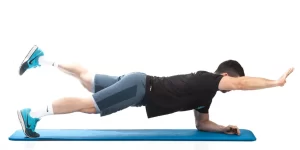
Lying Dumbbell Leg Raise
- How to do this exercise: To perform this exercise the patient has to Lie with faceup on the floor with elbows flexed 90 degrees, forearms, & palms down next to the sides.
- Place an 8- to 8-pound dumbbell between arches of feet with legs extended & slightly bent off the ground.
- While pushing the upper body off the forearms, lift the trunk until it is in a V position. Lower weight & legs back to the Starting position.
- Do 2–3 sets of 20 reps in a session. Do two sessions per day.
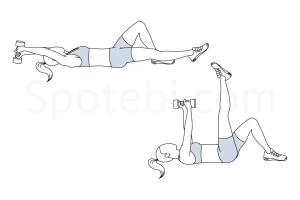
Overhead Ball Floor Tap
- How to do this exercise:
- To perform this exercise the patient has to Lie with faceup on the floor holding the medicine ball overhead with elbows facing the sky.
- Sit up explosively, bringing your legs into a wide V & lifting your feet; tap the ball on the ground between your legs.
- Lower back to start, tapping the ball on the ground behind you with arms extended.
- Do 2–3 sets of 20 repetitions in one session. Do three sessions in one day.
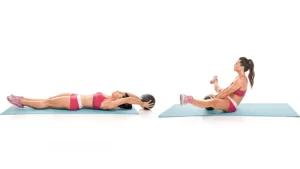
Lying Dumbbell Crunch
- How to do this strengthening exercise: To do this exercise a patient has to Lie on faceup, left ankle crossed over the right knee, right arm extended behind the head grab a light dumbbell in the right hand a few inches from the floor.
- Lift right shin parallel to the floor. Keeping left arm straight & right foot elevated, crunch up, bringing right hand toward the left shin, lifting head & upper back off the floor.
- Keep the left hand on the floor at the side.
- Do twenty crunches, make sure the head & feet are lifted; switch sides, and repeat. Do 2–3 sets on each side.
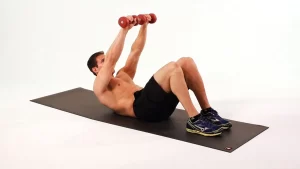
Overhead Barbell Sit-up
- How to do this strengthening exercise: To do this exercise the patient has to Lie in a faceup position on the ground holding up a 20-pound barbell or Body Bar over the shoulders, arms extended. Raise head & neck off ground, engaging abdominals.
- Sit up, lifting trunk & barbell upward until upper body is perpendicular to the floor. Slowly lower back to the starting position, and keep the abdominals engaged.
- Do 2–3 sets of 20 repetitions.
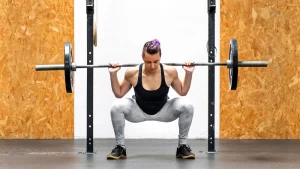
When did the patient not do the Rectus abdominis strengthening exercise?
- If the doctor advised you to take rest.
- If he is recently undergone abdominal surgery.
- If the patient feels any pain or discomfort while these exercises.
- If the patient has acute back pain, you take advice from a Physiotherapist before doing any exercise.
- If he has slipped disc in Back or sciatica pain.
FAQ
Crunch. Crunches are a classic core-strengthening move. The act of lifting the upper body works the abdominal muscles. If the patient has occasional low back pain, do crunches with care — move slowly and start with just a few reps.
MMT for rectus abdominis is usually done by asking the patient to bring his/her trunk against gravity from a supine position until the inferior angles of the scapula are off the table, and the therapist will start grading according to the patient’s performance and ability to do the movement as instructed.
It helps maintain internal pressure in the abdomen. Rectus abdominis: This pair of muscles goes down the middle of the abdomen from the ribs to the front of the pelvis. The muscles hold the internal organs in place & keep the body stable while moving.
The plank is the perfect isometric exercise for building abs. Add them to the routine three times per week or just get on the floor at home and knock them out daily. The patient will find that he has a flatter, more toned stomach in mere weeks.
Front planks are a great way to work the abs & obliques. Some people complain that you can’t get a ‘six-pack’ look by doing planks.
Though the patient is balancing the body weight on the arms & toes, most of the work in a plank is done by the core. In particular, the rectus abdominis, obliques, & transverse abdominis are utilized

